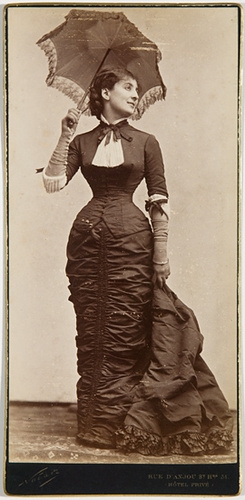
It’s true when you look at photographs from the 1800s or observe antique dresses on custom-made mannequins it’s not hard to envy those petite waistlines. Do you do this?
This perception usually leads to the generic thought: “Teeny, tiny waists are what women strived for back then. Everyone wanted an 18″ waist!”
But did they?…
I love Gone With The Wind. I do.
But I also don’t, because it’s put this *thing* in our modern heads that every girl wanted the smallest waist possible. That women back then cinched their corsets so tightly that they fainted.
Well I think this is a bunch of crap!
Honestly, it’s simply what people wore as clothing. And when we look at it through 21st Century eyes we see it as very, very restrictive. They can’t eat. They can’t breathe. They faint a lot. All for a little, itty-bitty waist. But that’s a 21st Century perspective. It’s a bunch of crap that they couldn’t live life normally.
We *think* they laced so tightly that they couldn’t breathe or eat. I personally don’t believe that.
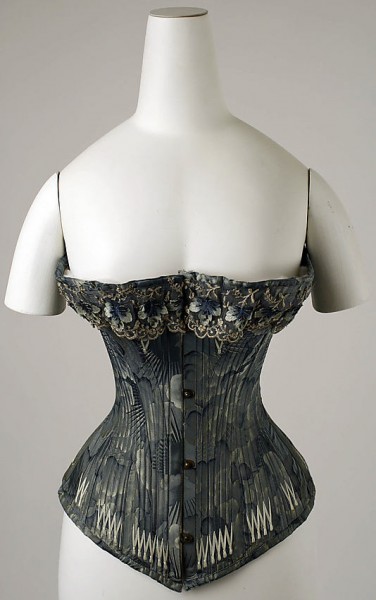
And the 18 inches thing – no. Forget it. ‘Cause when you look at original corsets and you measure them, the smallest ones usually measure between 20″ and 22.”
Then you start comparing numerous measurements and discover many of them fall into the 20″ to 26″ category. That’s the measurement of the corset. When wearing corsets you always allow about a 2″ gap and that’s on the small size. Many women wore them with 4″ gaps.
So say you add 2″ to a corset measurement. You then learn women’s natural waists were between 22″ to 28″. That’s not unheard of today! It’s merely on the small side.
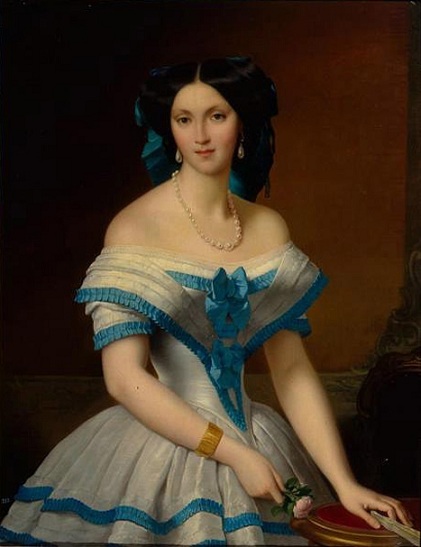
At this point, you have to look at the fact that these women were in corsets or some sort of restrictive garment since they were young teens. I don’t mean girls. Sure, some girls wore corset-type garments. But from a young teen and like 10-, 11-, 12-years old, they’re going to be in a lightly-boned corset.
So by training from that young age, you can alter the waist to a slim figure where it’s naturally going to be smaller because all that torso fat gets pushed to the hips and up to the bust. This creates a smaller waist over time.
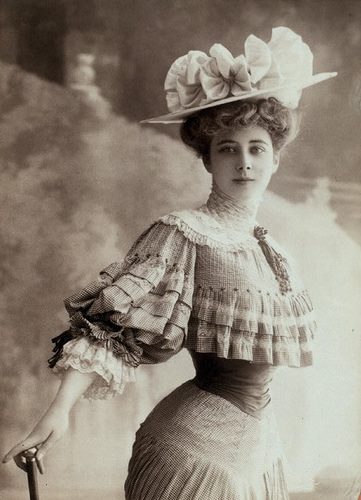
But back to the thought of the teeny, tiny waist thing – you’d think it’s all about “tight-lacing” – NO!
It’s all about the fashionable silhouette. It’s about the appearance. The perception of a small waist.
Women wore a corset to hold things in place. To lift the bust into a fashionable silhouette and support it. Doing so gave her more or less an hourglass shape.
Then what do you do? You add petticoats. You add contraptions like a bustle, a pad, padding to the hips, padding to the bust, petticoats, chemisettes & corset covers that have ruffles on them and dropped shoulder lines. And all this increases the hips and the shoulder appearance. It increases the width. It’s all about illusion.
It’s the impression that the waist is small. They’re not necessarily tight lacing down to 18″. No. Why? Because we have original garments to measure. They don’t measure 18″ in the waist. They measure 22″ to 26″. It’s using trickery to fool the eye into thinking the waist is teeny tiny.
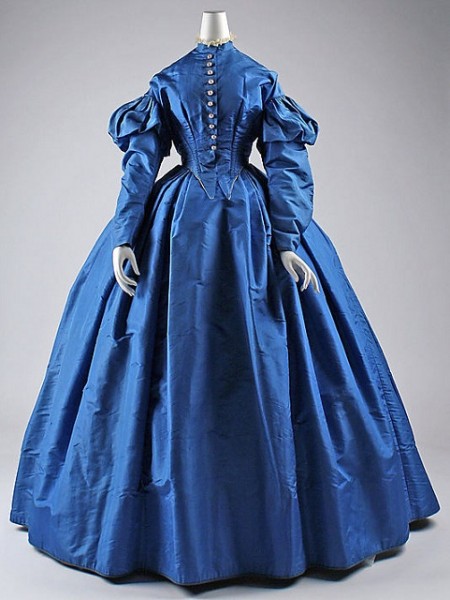
But the thing about corsets is that these women LIVED in them. They took care of kids in them. They went to tea and parties. They got out of bed every morning and put it on just like we get up every morning and put a bra and underwear on. It’s the same thing, it just looks different.
To them, they didn’t know what a bra and panties were. They had been wearing corsets all their lives, same as their mothers and grandmothers, and how many hundreds of years prior to that. Corsets go back quite a long ways.
That’s what they knew. Don’t you think they would have made corsets so that they could actually function yet still be fashionable?
We think of them as if they were fashion plates. Their photographs were of their best dresses. We view them as these stationary people. Not living and breathing, and “Oh, gosh I stubbed my toe on the table! And it hurts and I need to sit down ’cause it’s bleeding now.” “Gosh, I slammed my finger in the door.” Or “Henry’s just asked me out to the ball and I need a new dress.”
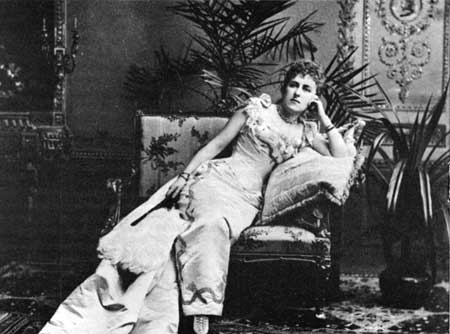
They were still living their lives. Because that’s what they did. We buy weird fashion to dress up and go out to imitate people and to impress other people. But we do it to reflect who we are. And that’s what fashion is. It’s how we connect with society.
They saw celebrities like the Empress Eugenie or Mrs. Vanderbilt with “small” waists. So women tried to imitate their look. Sure, they might have tightened their corsets. But they didn’t go so far as to restrict their movement.
You can’t study 19th C. clothing from a perspective of what would look out of place today. The slender waists we see on these women of the past look so small but that’s only to our 21st C. eyes. Of course they look teeny-tiny compared to our soft, unfitted knit clothing that hides our figures.
I’d bet if you were to put on a well-made, custom-fitted corset, added a strong bustle shape with a dash of proper petticoats – you’d begin to see that slim waistline start to appear. If you did that every day for a month… I’d guarantee you’d discover that itsy-bitsy waist.
Because it’s merely a 21st Century myth that all the waists were 18″.

Great article, as it points out we all have a waist, the diets were very different and the lifestyle for the masses was much more active than it is today. I believe that there is still a place in some people’s lives for corsets , I prefer mine as it provides a lot more strength and support without the harsh wires and cutting shoulder straps and when tailored correctly support bust weight themselves over the hips. There is something to be said regarding survivor bias as many garments that come up in the monthly sales often have the size ranges you speak of rather than the super tiny waists. But people do go to extremes as some people still do in the name of fashion.
Your article does not account for the numerous bikini models of the 1950s with small waists. They did not do waist training as far as I know.
hello Dirk 🙂 this article refers to the 19th century (1800-1899), not the 19th century (1900-1999). the bikini gained western popularity around the 1960s after debuting in France in 1946. So women had mostly moved on from corsets in favor of girtles, spanx, and early modern underwear like separate bras and panties. This article refers to the fashionable wasp-waisted silhouette of the 19th century, which was achieved via corseting. so bikinis are not really relevant here. the silhouette of a bare human waist is not comparable to the shape and proportion one can achieve via corseting. hope that helps.
There’s also survival bias. The things that end up in museums are the ones that weren’t handed down and were worn to shreds, or picked apart to make other things. Every-day clothes, especially working-class clothes that women had to move around in wouldn’t survive. And we should bear in mind that even servants wore corsets — they acted as back support for heavy lifting, much like a weight belt does today.Larger things disappeared. Anything with enough fabric in it would be re-fashioned into a newer style, perhaps for a smaller daughter. Just like when we go into a sale today and the only items left on the rack are teeny-tiny, it’s the same with what survived to get handed down to museums.
Another point to add in: Late Victorian and Edwardian photographs were actually photoshopped! The waist would be painted over to match the background, making it look even smaller. This was especially popular with the “influencers” of the day
I love this, someone out there is taking time to really look at a corset and not see it as some kind of horrible device!
As someone who has worked/played in historical 18 hundreds clothes for years I hate that they get such a bad rap.
Though I do believe tight lacing is a terrible thing it wasn’t because men forced us to, it was women going to the absolute extreme for what they thought looked fashionable. And we still see that today!